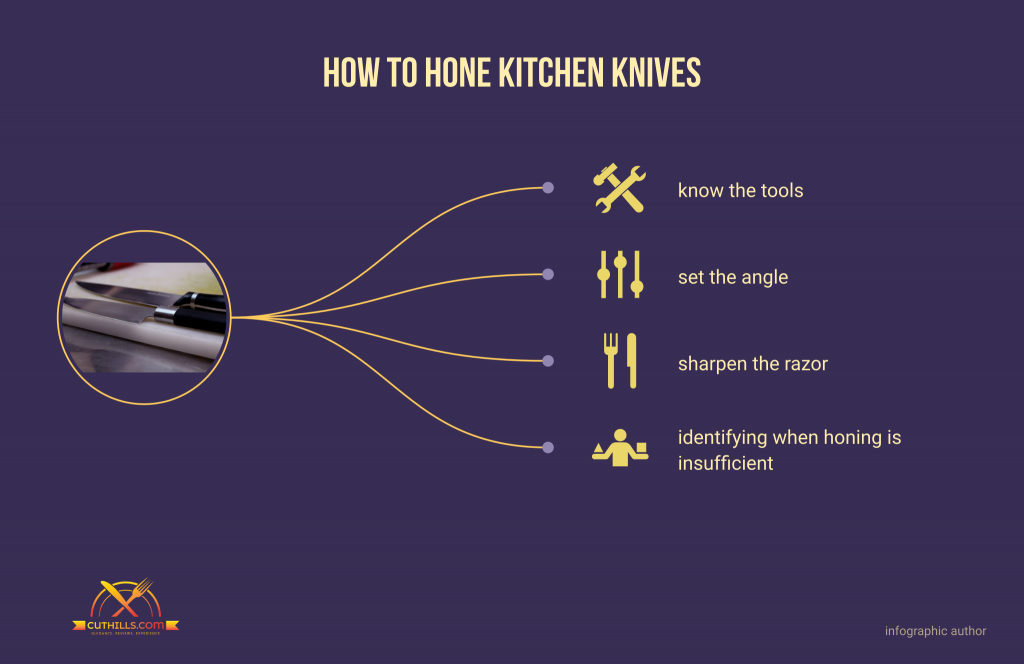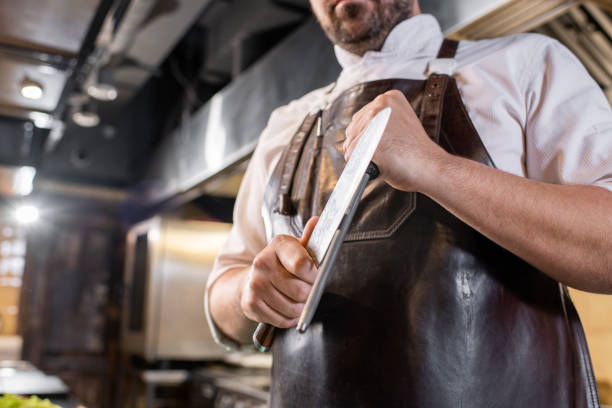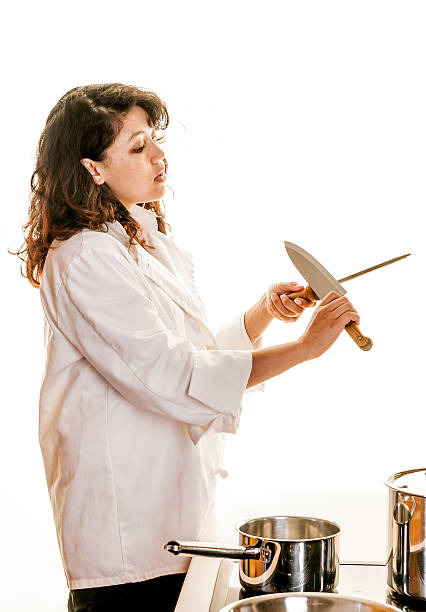To keep kitchen knives in good shape and make them last longer, you need to know how to sharpen them and fix the honing edge. For serious cooks, the most important kitchen tool is a sharp knife. The edge and sharpness of a knife can be kept and improved by stropping it regularly and honing it every so often. So, what’s behind knowing how to hone kitchen knives to make them sharp?
Stropping and honing aren’t the only ways to sharpen a knife; rather, they come after the initial sharpening procedure. In this piece, I’ll talk about the differences between stropping, honing, and traditional sharpening. Also discussed will be the broader significance of sharp knives, as well as some other methods to think about.
How to Hone Kitchen Knives: Understanding the Honing Process

As was noted, honing is done to a knife that is already sharp in order to keep the edge and condition of the blade intact. Knives are sold with a factory edge since that is how they are typically first used. The edge loses its sharpness and its straightness. It begins to show signs of wear from scratches and nicks as time passes.
Thankfully, honing doesn’t require a ton of complicated or expensive tools and can be done in the comfort of your own home. In reality, when you hone a knife, you aren’t so much resharpening it as you are just making sure the edge is nice and straight. It’s true that honing doesn’t actually make the blade sharper, but it does realign the blade so that it seems sharper. Each time you use a knife, you should sharpen it and have an idea of how to hone kitchen knives to implement it.
The Importance of Honing and Sharpening Knives
We’ve touched on the reasons why knife maintenance is important because knives that aren’t sharpened and stropped regularly lose their edge and become crooked much more quickly. Yet there are additional drawbacks to neglecting a dull knife. Vegetables with tough skin, like carrots, will not be as easy to chop with a dull knife.
In addition, a dull knife is a potential safety hazard. Cutting with a dull knife increases the risk of dropping the item being cut. This increases the danger to the user’s hand and fingers since the user is likely to apply more force, increasing the knife’s speed as it slips. Because of this, the user’s hands and fingers are at a far higher risk of being accidentally harmed, such as by getting cut.
How to Hone Kitchen Knives: Honing vs. Sharpening Knives
What we need to differentiate here is between honing and sharpening a kitchen knife. The typical household “knife sharpener” is also known as a “honing steel” or “butcher’s steel“. The long metal rod found in the heart of a knife block is really used to hone blades, not sharpen them. A knife’s edge, on the other hand, can be made straight and ready for use by using honing steel. You can’t make a clean cut with a knife because the tip will eventually curl and bend as you use it.
1-Know the Tools

Honing steel, often known as butcher’s steel, is the standard tool for sharpening knives. Using one of these before each usage is a great way to keep your blades in tip-top shape and ensure that they always make a clean cut.
Maintaining sharp blades requires more than just honing steel. A sharpening stone, often called a “water stone,” is a flat, square stone that can be purchased in either a coarse or fine grit. It depends on the knife type and desired level of sharpness.
Honing kits, which can be bought separately, have different types of sharpening stones with different grits. Even though we’ll be discussing honing steels, these same principles may be used to sharpen stones.
2-Set the Angle
Don’t act like a celebrity chef on television and start swinging your knife and honing steel in the air. The next proper way how to hone kitchen knives is to hold the honing steel vertically and point it down into the towel or dishcloth. Then put it down firmly on the counter. Then, place your knife at a right angle (90 degrees) to the middle of the sharpening steel.
Next, incline the blade such that it is no longer perpendicular to the steel but also not parallel to it. Using this method, your blade should be at a 45-degree angle. Put the handle at a 45-degree angle to the steel once more, halfway between that and parallel. When done this way, expect to achieve a 22-degree angle between the knife and the honing steel.
Most knives made in the West have a blade that is angled 20 degrees to each side of the vertical during the molding process. To become used to holding the knife at this angle, practice holding it in your hand. When sharpening with a stone, the method will be different, but the rule still stands the angle matters.
3-Sharpen the Razor
Once you’ve mastered the slant, sharpen your blade. Bring the blade forward until the steel is touching the knife’s heel. Holding the weapon at a 22-degree angle, pull it back toward you along the entire blade until you reach the tip. Just flip the blade over to clean the other side.
If your knife isn’t too far out of whack, you should be able to do these 4 or 5 times and then use it without issue. Doing this before you use a knife is a great way to make sure that the blade is in the right place and that it is safe to use.
4-Identifying When Honing Is Insufficient
Regular sharpening of knives is essential, but once the edge of a blade really dulls or chips. As opposed to simply becoming misaligned, there is still something you can do for the tool’s restoration. Though, if you use honing steel and take good care of your knives, then you may be able to get by with just one set for the rest of your life.
Even if you sharpen your knife frequently, if your go-to blade isn’t cutting like it used to, it may be time to have it touched up by the pros. You should get your knives properly sharpened at least once a year, and more often if they are used frequently. Depending on the knife’s length and material, the cost to have it sharpened by a professional can range from $10 to $25. It’s a steal when compared to the price of brand-new blades.
How to Sharpen and Hone Kitchen Knives

Metal has the advantage of being easily shaped because of its malleability. As a result, even light use in the kitchen can cause tiny dings in the blade’s thin honed edge, which can eventually cause the knife to be misaligned. A honing steel is perfect for this purpose. With proper use, steel can realign the blade’s edge so that the sharpened portion always points in the same direction.
Your knife will always have the sharpest edge if you sharpen it before each use. The best steel to buy is a heavy one that is at least 9 inches long. Excellent steel will last forever, like a well-made knife. The ridges may fade with use, but the product is still functional.
Step 1: Start at the Heel
The vertical grip is widely accepted as the best and most comfortable option. Aim the blade at the cutting board while holding the handle. You should lean the knife’s heel against the steel’s top at an angle of about 15 to 20 degrees.
Step 2: Finish at the Tip
Pull the knife down the iron with a light hand and use the whole length of the blade at the same angle.
Step 3: Begin Second Side
The knife’s heel should be held on the steel’s other side, at an angle of 15 to 20 degrees.
Step 4: Finish Second Side
To join the knife’s tip with the steel’s, move the blade over it. When honing a blade, it is best to use around 8 strokes on each side.
Step 5: Advanced Method
Diamond steel is just one example of a cutting tool that may be used in conjunction with a floating hold to make cutting food even more efficient and convenient. Nonetheless, it’s trickier to keep under wraps. In your non-knife hand, hold the steel horizontally and rest the blade’s heel against the steel’s base.
Step 6: Advanced Method Continued
For best results, keep a 15° to 20° angle between the knife and the steel as you draw it across. Flip it over and do it again. At this point, your knife ought to be level.
The Right Time and Method for Honing Knives

In reality, it may be hard to get a knife back to the sharpness it had when it was first made. But with practice and the right tools, a dull knife can be returned to its former sharpness especially if you have an idea of how to sharpen and how to hone kitchen knives. When you sharpen a blade, you put it through a much more forceful process that changes its shape from the bottom up. This is in contrast to honing and stropping, which only change the shape of the blade slightly. For this purpose, you’ll need something tougher than the metal your knife is made of.
There are three main types of knife sharpeners available today: whetstones, electric sharpeners, and manual sharpeners. A dull knife can be sharpened using any of these methods, but there are important distinctions between them.
*️⃣Whetstones
These fine-grained stones, known as whetstones, typically come in the shape of a rectangular block. Using a whetstone to sharpen a knife is a completely manual process that requires an expert to know how to move the knife around the stone at the right angle and with the right amount of pressure. Whetstones, on the other hand, allow for the most personalized sharpening experience.
*️⃣Power Tools for Knives
To sharpen a knife, you just have to slide it through a machine with abrasive-coated motorized wheels. Unfortunately, these are usually quite pricey and don’t accommodate the full length of a blade. Then the latter ends up being unevenly sharpened.
*️⃣Traditional Knife Sharpeners
Though they use the same principle as electric sharpeners, manual knife sharpeners don’t have motorized wheels. If you want something easier than a whetstone but more affordable than an electric sharpener, they can be a good compromise. A whetstone is superior to a manual knife sharpener in terms of precision.
Honing Kitchen Knives: A Diamond Steel
The diamond steel I have is of a thinner length and is covered with tiny diamond particles. Diamond-tipped steel will really shave off a few of your knives as you use them as opposed to conventional steel, which will only straighten your blade. It’s not ideal for regular use, but it will help your knife last longer before it needs to be sharpened again.
Hone Kitchen Knives: The Honing Steel
The traditional honing steel takes the form of a rigid steel rod. As a knife is drawn over the ridges, they are gently brought back into proper alignment. Before each use, sharpen your knife with regular steel.
How to Know When to Hone or Strop a Knife
To determine if a knife is becoming too dull, it can be tested in a number of different ways. Trying to cut a sheet of standard printer paper in half horizontally while holding the two ends in different hands is a common thing to do. Keep an eye out for these warnings when you cut the paper:
- If the blade of the knife readily slashes through the paper, it is in good shape and doesn’t need frequent sharpening.
- If the knife cuts well for the most part but becomes jammed at the tip when you first start cutting, you probably need to sharpen it.
As soon as you see that your knife is catching on the paper fibers and won’t cut smoothly, have it sharpened. Re-sharpening the knife may be necessary if, after honing and/or stropping, it still won’t cut paper smoothly.
While using a piece of paper to determine whether or not a knife is dull is a reliable method. A person who frequently uses the knife in question is more likely to notice the dullness on their own. Tomatoes and bell peppers, which have tough skins, show how dull a knife is more than any other vegetables.
How Frequently Should Knives Be Honed?
If you want your knives to remain as sharp as possible, you should sharpen them after each use. Preventative maintenance includes sharpening blades using a honing steel. If you take the time to sharpen your knife’s edge with a honing stone, you may be able to avoid using more powerful sharpening tools for much longer. Maintaining your knife properly is an integral part of honing your knife skills.
Maintenance of a Knife Includes Both Stropping and Honing

Sharpening and taking care of your kitchen knives should be a normal part of any cooking routine. Knives are incredibly valuable instruments, but like any other tool, they require care and respect to perform at their best. You can keep your kitchen knives in top shape for a long time by honing and stropping them regularly. Stropping is not necessary and is usually done for looks, it is still best to sharpen knives after each use.
When these two steps are done together, blades can keep their best brightness and edge quality for a lot longer. In addition, honing and stropping equipment is typically more affordable than sharpening equipment. So, if you regularly sharpen and hone your knives and other kitchen tools, you won’t have to buy new ones.
Frequently Asked Questions
Q: Exactly what occurs if a knife is honed improperly?
To reiterate, know the knife’s edge well; honing at the incorrect angle will only make the blade less sharp.
Q: Does honing a knife need wiping it down?
To sharpen a knife, run it along a honing rod at an angle of 10-15 degrees, making several passes with pressure applied to the blade. Do not use the blade to prepare food without first wiping it down; otherwise, you risk ingesting tiny metal fragments.
Q: Does over-honing a knife ruin it?
You can ruin a knife’s edge by sharpening it too many times, and this is especially true if you’re using a V-sharpener, an electric sharpener, or a rough diamond stone. In general, you might not need to refine your knives with over twice a year if you’re maintaining them properly.
Final Thoughts
Most cooks should be able to sharpen their own knives. But there is no single, foolproof method for doing so or for learning to sharpen knives professionally. Before going out on their own, many skilled sharpeners learn their trade for years from an experienced master.
Use extreme caution if you are learning how to sharpen and re-edge blades. The use of a newly sharpened knife is unparalleled. A well-maintained and regularly sharpened kitchen knife, however, can serve its owner for many years to come.
